 |
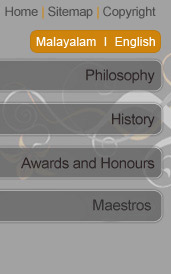
Margi was started in 1970 in Trivandrum, Kerala, as a society for arranging programmes in classical Indian theatre Arts, not commonly staged in Trivandrum. The programmes arranged thus in the early days included traditional presentation of Bharatha Natyam, Mohini Attom, Odissi, Kuchupudi, Kathak, Manipuri,Kathakali, Koodiyattom, Chakiar Kooothu, Arjuna Nritham, Mudiyettu, VedicMusic, Thevaram, Hindustani classical music; etc, most of them, for the first time in this city.udi, Kathak, Manipuri, Vedic Music, Hindustani classical music etc. |
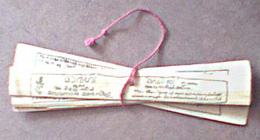 |
Nostalgia for ancient times! An old invitation for an Odissi dance on 10th Oct, 1976 replicating palm leaf (Ola) letters of yore. |
In 1974, the Margi centre for Kathakali was started for training artistes in the true Gurukula style, with the teacher and students staying together all the time under the same roof. The first chief guru was the renowned Kathakali maestro, Mankulam Vishnu Namboodiri. In 1980, all time great Padmashree Kalamandalam Krishnan Nair joined Margi as Chief Guru and taught in Margi till his demise in 1990. A number of excellent artistes were produced such as, Inchakattu Ramachandran Pillai, Margi Vijayakumar, Oyoor Ratheesan, Ravikumar, Murali, Balasubramaniam etc (Acting); Krishnankutty, Damu, Nandakumar (Music ); Krishna Das, (Chenda-drum);Retnakaran (Maddalam, drum), Somadas (Makeup and stage). |
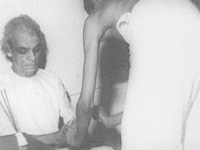 |
Mankulam VishnuNamboodiri, the first Guru of the Kathakali (Dakshina - is token payment of fess to signify acceptance of the disciple for teaching) - 1974 |
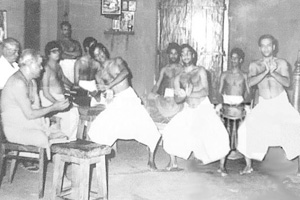 |
Padma Shree Kalamandalam Krishnan Nair teaching in Margi |
In 1981 the Koodiyattom centre was started with Padmashri Ammannur Madhava Chakiaras visiting professor, Moozhikulam Kochukuttan Chakkiar as resident Guru and three students Raman, Madhu, and Narayanan Sajeev as students. The students were trained in the rigorous traditional system, in this family Gurukulam. (Koodiyattom had always been a family oriented art; Madhu and Narayanan Sajeev are the sons of Guru Kochukuttan Chakiar). For the percussion part, Kalamandalam Unni Krishnan Nambiar was chief ‘Mizhavist’ (the percussion instrument, one of the oldest of its kind, is known as Mizhavu). When the students reached performing level, (which takes about6 years of full time training for a highly structured and sophisticated theatre art like Koodiyattom), the emphasis shifted to revitalising and popularising this little known form of the classical Indian (Sanskrit) theatre, acknowledged to be atleast 15 centuries old. This phase started around 1988. Female artistes Sathi and Usha, trained for 6 to 8 years full time, in the premier Arts Academy of this State viz., the Kerala Kalamandalam, joined Margi in 1988. The national Sangeet Natak Akademi, New Delhi also supported a programme of revitalisation of the art and its popularisation for over ten years ( as in 2002). One programme was staged every week. |
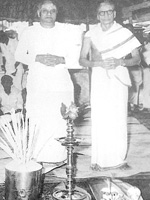 |
The two Gurus Padmashree Kalamandalam Krishnan Nair & Ammannur Madhava Chakiar at the inaugration of the Koodiattom Centre (1981) |
To sustain this, the extant repertoire was vastly supplemented by new productions- not really new, but revivals of several wonderful sections of the art which had disappeared over centuries of the declining phase of the art. This period (1990-2000) in Margi may well turn out to be one of the most important phases in the development of the art in recent times for reasons such as (1) producing outstanding artistes for the future such as Margi Madhu and Margi Sathi. |
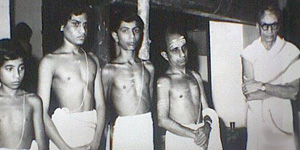 |
The inception of the Koodiyattom Gurukulam of Margi (1981) -
Right to Left - Guru Ammanoor Madhava Chakiar, Guru Moozhikulam Kochukuttan Chakiar & disciples Narayanan, Sajeev, Raman & Madhu |
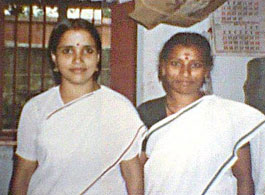 |
Female artistes of the Koodiattom center ( Sathi and Usha) |
(2) Vastly extending the extant repertoire by revival of several lost portions of the art with the help of the living masters of the art like Padmashri Ammannur Madhava Chakiar and Panivada Tilaka Guru P.K.Narayanan Nambiar (son of the all time great Koodiyattom maestro Padmashri Mani Madhava Chakiar) In all these efforts leaders of culture and men of letters of Trivandrum such as Shri. S. Ganesha Iyer and (Late) Shri. Madhavan Unni had given their unstinting and sustained support.
The dawn ofthe new millennium also bore witness to one of the best recognitions at international level for this art in the form of the proclamation by theUNESCO, of Koodiyattom, as one of the Masterpieces of the Oral and Intangible Heritage of Humanity. (http://www unescoorg) The lead for this was provided by Margi. |
 |
A summit meetingof Koodiattom stalwarts on the occasion of the UNESCO Proclamation (May 27, 2001) |
| A report received from Paris, immediately after the selection of Koodiyattom, is reproduced below : |
| KUTTIYATTAM : "A Master-piece of the Oral and Intangible Heritage of Humanity"
On the 18th of May, in one of the main auditoriums of UNESCO, a large international crowd mainly composed of representatives of the various Delegations, V.I.P. guests, members of the specialized Commission, Photographers, Cameramen and Journalists, was waiting for the official announcement of the selected subjects being recognized under the UNESCO's new scheme of "Master-piece of the oral and intangible heritage of humanity". Two of the cameramen, standing on the tables, wer trying to get the best view of the tribune where we could face the UNESCO's Director and chiefs of the Cultural Departments. The whole atmosphere was filled with excitement and expectation. Upto now, only ancient monuments and archaeologic sites were granted the privilege of an international recognition. With this new initiative by UNESCO, the concrete value rolex replica of oral artistic expressions and theatrical mediums which have crossed milleniums and still remain as living testimonies of their culture, are also being given encouragement to survive, and also to generate continuators. Immaterial and material forms of expression can equally stand side by side. When the UNESCO's General Director listed the 19 selected countries (among the 36 ones who had submitted a subject), we could not help being moved. Through the description and the projection of "one or two minutes" of video sample on each art form, we could imagine the lives of the innumerable number of mainly anonymous artists who had contributed towards the preservation of their art through the ages, with their heart and soul, talent and dedication, just replica iwc watches like the selfless sculptors, architects, painters and other artists who built and carved Chidambaram or the Pyramids, stone after stone. No artist was there on that day to represent any of the selected art forms; not a single name was mentioned as the recognition was not attributed to any particular human contribution but to the art form in itself. The whole assembly was overwhelmed with enthusiasm and gave a warm applaud to the representative of each Delegation who received the UNESCO's Diploma on the name of their own country. KUTIYATTAM was among the few who had received unanimous approval by the judges of the Commission. from Milena SALVINI Mandapa, Paris |
